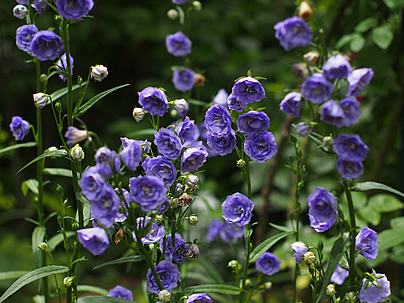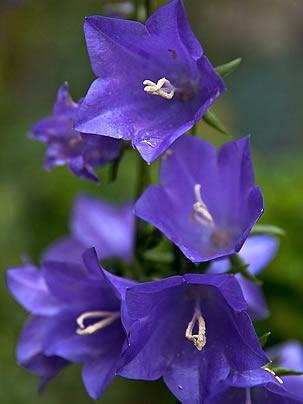The Peach-leaved Bellflower (Campanula persicifolia) is a perennial, herbaceous, and highly floriferous plant, originating from alpine regions of Europe and western Asia. It features an erect, sparsely branched stem arranged in loose tufts from the rhizome. The leaves are bright green, with rounded teeth on the edges, spatulate at the base, and lanceolate to obovate, becoming narrower along the stem.
Flowering occurs from late spring to summer, producing terminal raceme inflorescences with large, open bell-shaped flowers, ending in five points like a star. They can be blue, white, lilac, or pink, depending on the cultivar. The subsequent fruit is a capsule type with clearly visible veins.

Peach-leaved bellflowers add delicacy and charm to the garden. Their bluish flowers blend perfectly with English-style Cottage gardens, informal and with a simultaneously rustic and romantic aura. For a more interesting effect, it is advisable to plant them in groups, forming flowerbeds or mixed borders.
Versatile, they are commonly used to cover the defoliated stems of shrubs and rose bushes. In Brazil, they are more often seen as potted plants, used to decorate homes for a few days, rather than in gardens. The erect, flowering branches are also excellent as cut flowers, used in bouquets and floral arrangements.
They should be grown in full sun or partial shade, in fertile, well-drained soil, enriched with organic matter, and watered regularly. They do not tolerate the intense heat of summer, which is why they are treated as annuals even in the cooler regions of Brazil.
Due to their preference for cool climates, peach-leaved bellflowers can only be cultivated in fresh, high-altitude locations, such as the mountainous regions of southern Brazil. After flowering, old flowers can be cut off to stimulate new blooming. Propagation is through division of the tufts, cuttings, and seeds.
Seeds germinate between 14 and 28 days, require light, and a substrate kept moist. After germination, they can be lightly covered with a thin layer of substrate and should be transplanted into small bags when they have two true leaves. Seedlings should be pinched during development to produce denser tufts.

